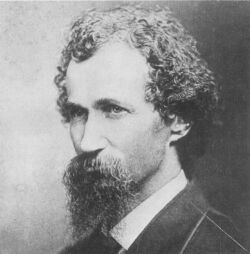"Bell-Birds" is a poem by Australian writer Henry Kendall that was first published in The Sydney Morning Herald on 25 November 1867.
"The Creek of the Four Graves" is a poem by Australian writer Charles Harpur that was first published in three parts in The Weekly Register of Politics, Facts and General Literature on 9 August, 16 August and 23 August 1845.
In Answer to Various Bards is a poem by Australian writer and poet Andrew Barton "Banjo" Paterson. It was first published in The Bulletin magazine on 1 October 1892 in reply to fellow poet Henry Lawson's poem, In Answer to "Banjo", and Otherwise.
"The Drover's Wife" is a dramatic short story by the Australian writer Henry Lawson. It recounts the story of an outback woman left alone with her four children in an isolated hut.
A Mid-Summer Noon in the Australian Forest is a poem by Australian poet Charles Harpur. It was first published in The Empire magazine on 27 May 1851, and later in the poet's poetry collection Poems (1883).
Where the Dead Men Lie is a poem by Australian poet Barcroft Boake. It was first published in The Bulletin magazine on 19 December 1891, and later in the poet's poetry collection Where the Dead Men Lie, and Other Poems (1897).
The Women of the West is a poem by Australian poet George Essex Evans. It was first published in The Argus newspaper on 7 September 1901, and later in the poet's poetry collection The Secret Key and Other Verses (1906).
"The Last of His Tribe" is a poem by Australian writer Henry Kendall that was first published in The Sydney Morning Herald on 30 September 1864, under the title "Woonoona: The Last of His Tribe".
Andy's Gone With Cattle is a poem by Australian writer and poet Henry Lawson. It was first published in The Australian Town & Country Journal on 13 October 1888.
A Bush Christening is a humorous poem by Australian writer and poet Andrew Barton "Banjo" Paterson. It was first published in The Bulletin magazine on 16 December 1893, the Christmas issue of that publication. It has been called "a rollicking account of how the traditional pre-occupations, whisky and religion, come together".
The Sick Stockrider is a poem by Australian poet Adam Lindsay Gordon. It was first published in Colonial Monthly magazine in January 1870, although the magazine was dated December 1869. It was later in the poet's second and last poetry collection Bush Ballads and Galloping Rhymes (1870).
"Bill the Bullock Driver" is a poem by Australian writer Henry Kendall that was first published in The Australian Town and Country Journal on 1 April 1876.

The Teams is a poem by Australian writer and poet Henry Lawson. It was first published in the Australian Town and Country Journal on 21 December 1889. It was later published in the poet's poetry collection In the Days When the World Was Wide and Other Verses in 1896.
Where the Pelican Builds is a poem by Australian poet Mary Hannay Foott. It was first published in The Bulletin magazine on 12 March 1881, and later in the poet's collection Where the Pelican Builds and Other Poems (1885).
"The Song of Ninian Melville" is a poem by Australian writer Henry Kendall that was first published in the author's suppressed edition of his poetry collection, Songs from the Mountains in 1880. The poem is a set of verses satirising Ninian Melville, at that time Member for Northumberland in the Parliament of New South Wales. Immediately after publication the publisher, believing the political satire to be possibly libellous, recalled the edition after some 250 copies had been distributed. The satire was excised and replaced by the poem "Christmas Creek". The book was re-published in January 1881.
This article presents a list of the historical events and publications of Australian literature during 1957.
T. Inglis Moore (1901-1978) was an Australian writer, anthologist and academic who was born in Camden, New South Wales.
This article presents a list of the historical events and publications of Australian literature during 1963.

